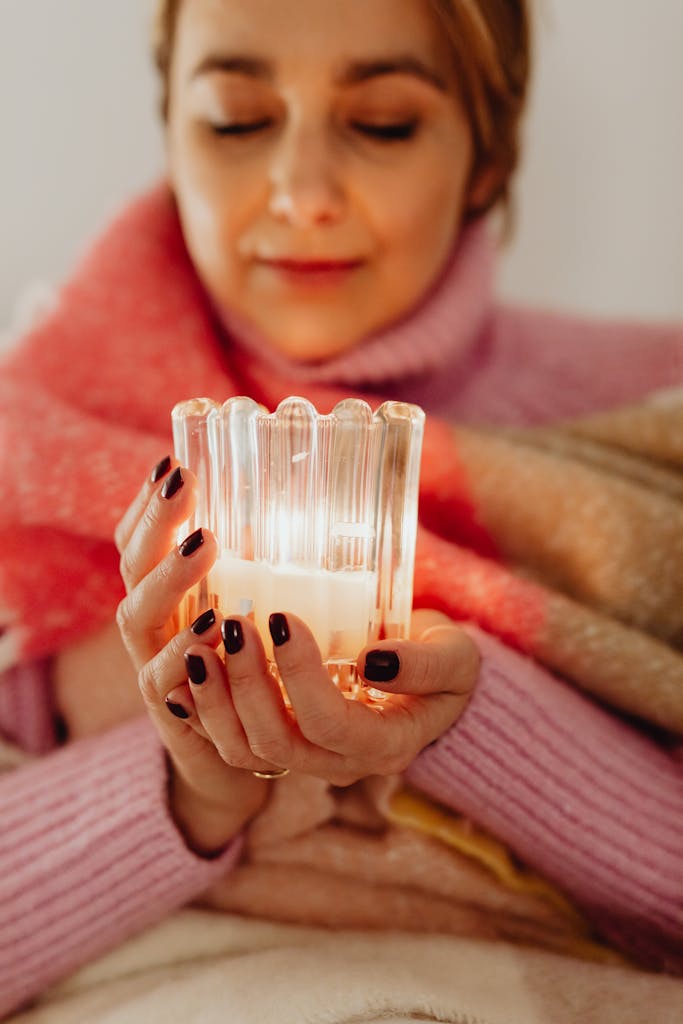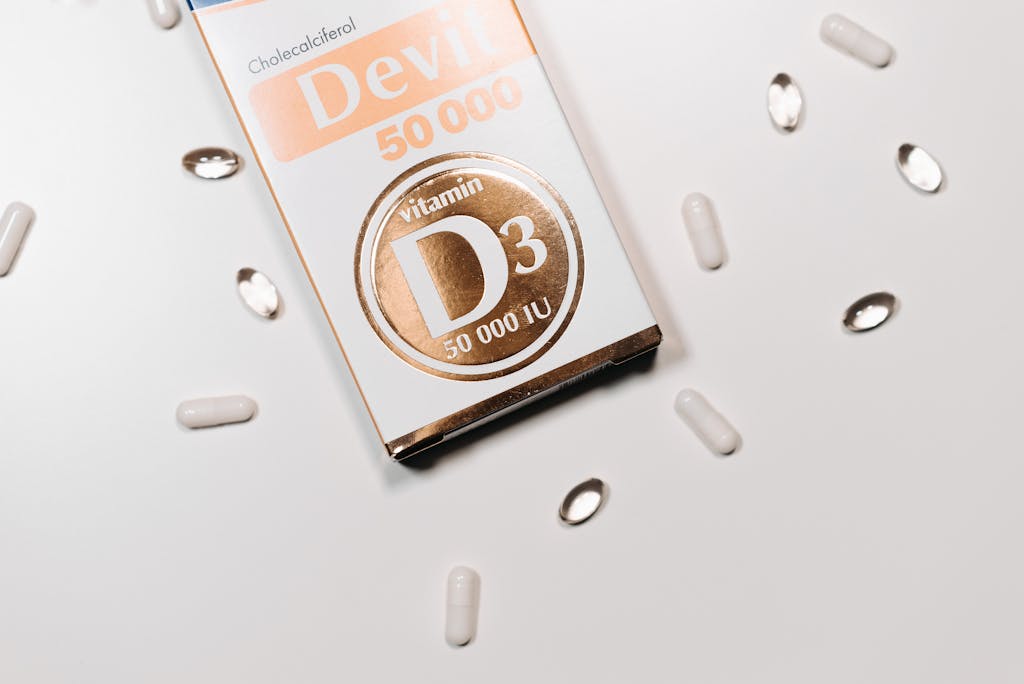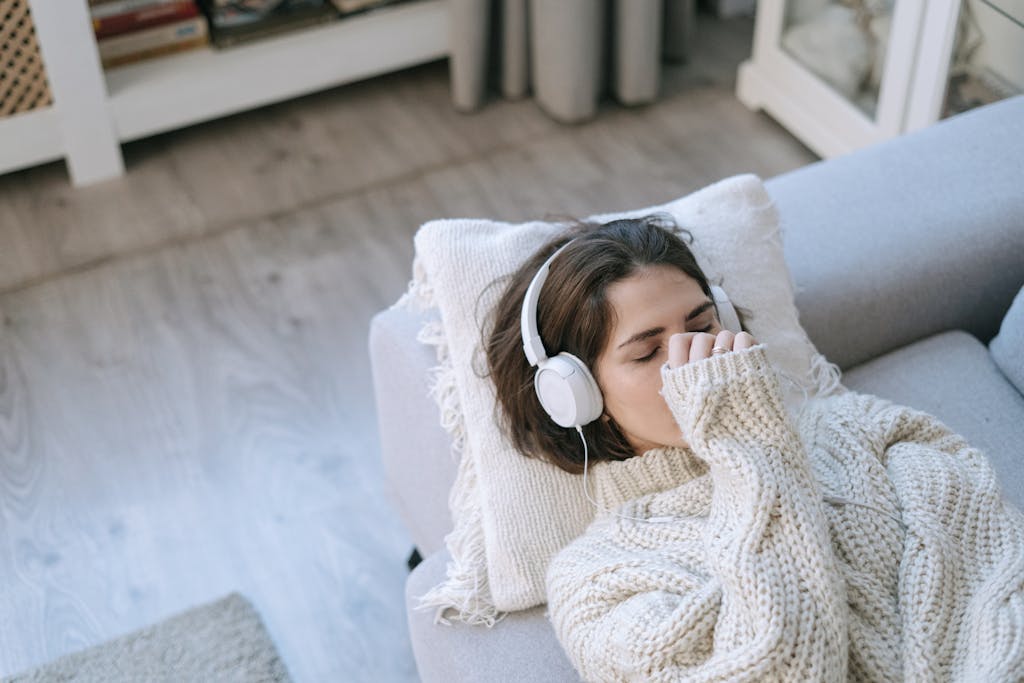
If you’re like me and start feeling like a grumpy hibernating bear the moment daylight saving time ends, you’re not alone in this seasonal struggle. Those shorter days and endless gray skies can turn even the most cheerful person into someone who considers pajamas acceptable work attire. But here’s the thing – you don’t need expensive prescriptions or a winter vacation to Hawaii to fight back against the seasonal blues, and I’ve got fourteen surprisingly simple strategies that’ll help you reclaim your energy.
Key Takeaways

- Get 30 minutes of morning sunlight daily and use 10,000 lux light therapy boxes to boost serotonin levels.
- Exercise for 30 minutes each morning with cycling or brisk walking to trigger natural antidepressant production.
- Take 2,000-5,000 IU vitamin D supplements daily before winter and eat omega-3 rich foods like salmon.
- Practice morning mindfulness with breath awareness and schedule weekly social activities to combat isolation.
- Create cozy environments with warm lighting, soft textures, and play uplifting music to enhance mood naturally.
Maximize Natural Light Exposure

When the days get shorter and my mood starts to tank, I’ve learned that chasing every bit of natural light becomes my number one priority. You’ve got to fight back against those seasonal patterns that mess with your head, and light is your secret weapon.
I spend at least 30 minutes outdoors every morning, even when it’s cloudy—trust me, you’re still getting more daylight than sitting inside scrolling your phone. Those light therapy lamps? Worth every penny of the $40 I spent.
I ripped open all my blinds and even trimmed the overgrown bushes blocking my kitchen window last fall. Now I sit near windows whenever possible, soaking up that precious time outdoors and natural light like it’s my job. For the best light penetration, clean windows on a cloudy day when you won’t get streaks from the sun drying the glass too quickly.
Try Light Therapy
Since natural light alone wasn’t cutting it during those brutal January mornings, I finally caved and bought one of those light therapy boxes everyone keeps raving about. Game changer, honestly. You’ll want a 10,000 lux model that delivers bright light for about 30 minutes each morning. I set mine up right next to my coffee station, so it’s impossible to forget.
The science is solid – light therapy boosts your serotonin levels while fixing those wonky circadian rhythms winter destroys. Start using it before your seasonal funk hits, ideally in October or November. Keep your sessions consistent, same time daily. Within two weeks, you’ll notice less brain fog, fewer carb cravings, and actual motivation to tackle your goals again.
Creating a dedicated space for your light therapy session can transform this treatment into a peaceful morning routine that brings both healing and tranquility to your day.
Get Moving With Regular Exercise
You don’t need expensive light boxes to fight those winter blues, because your own two feet can work just as well as any fancy gadget.
When you get your heart pumping with just 30 minutes of cycling or brisk walking, you’re basically giving your brain a natural antidepressant boost that rivals professional light therapy sessions. The best part is that moving your body triggers a flood of feel-good serotonin, which means you’ll be trading those gloomy feelings for genuine energy and mood improvements.
If outdoor exercise feels too challenging during darker months, setting up a home gym can provide the perfect solution for maintaining your mood-boosting workout routine regardless of weather conditions.
Exercise as Light Therapy
While you might think hauling yourself to the gym sounds about as appealing as a root canal, here’s something that’ll surprise you: just 20 minutes of stationary biking can work as well as those expensive light therapy boxes for beating seasonal depression. Your brain doesn’t care if you’re getting mood-boosting power from a $200 lamp or a basic workout—it’s cranking out serotonin either way.
Exercise literally rewires your brain chemistry, giving you the same antidepressant effects as light therapy for seasonal affective disorder. The key is timing though. Morning workouts are your secret weapon since evening exercise can mess with your natural melatonin production. Stick to a consistent routine, even when winter makes you want to hibernate, and you’ll stay ahead of those seasonal blues.
Boost Serotonin Through Movement
Movement triggers your brain’s serotonin factory better than any antidepressant pill you’ll find at the pharmacy. When you commit to regular aerobic exercise, you’re literally rewiring your brain chemistry to fight off winter’s emotional assault.
I’ve discovered that just twenty minutes on my stationary bike produces the same mood-lifting effects as expensive light therapy boxes.
Your serotonin activity skyrockets when you establish a consistent exercise routine, especially if you tackle it first thing in the morning. Don’t underestimate outdoor activities like hiking or snowshoeing – they’re double-duty powerhouses that combine movement with natural light exposure. You’ll regulate your circadian rhythms while building mental resilience that lasts all season long. Skip the gym membership guilt and focus on consistency instead.
Take Vitamin D Supplements

One simple supplement can make a surprising difference in your winter mood, and I learned this the hard way after spending three miserable January mornings wondering why I felt like hibernating under my covers forever. That’s when I discovered vitamin D supplements could tackle seasonal affective disorder head-on, working better than expensive light therapy sessions for my stubborn depression.
Start early – Take 2,000-5,000 IU daily before winter hits, not after you’re already miserable
Be consistent – Your brain needs steady serotonin and dopamine support, not sporadic doses
Give it time – You’ll notice mood improvements within 2-3 weeks of regular supplementation
This $12 bottle became my secret weapon against seasonal blues. For additional support during tough emotional periods, consider reading books focused on emotional healing and resilience, which can provide powerful tools for maintaining mental wellness year-round.
Maintain a Balanced Diet
Supplements work wonders, but I discovered my biggest seasonal mood breakthrough came from what I put on my plate every single day. Your brain craves power foods during dark months, and a balanced diet delivers exactly that ammunition. I started loading up on omega-3 fatty acids from salmon twice weekly, walnuts for snacks, and flaxseeds in my morning smoothies. These nutritious choices literally rewired my winter mindset within three weeks.
You’ll want to prioritize colorful vegetables, lean proteins, and whole grains that supply essential vitamins and minerals your body desperately needs. I ditched those afternoon cookie binges that sent me crashing harder than my motivation levels. Instead, I focused on steady fuel that kept my energy consistent. Starting your day with protein-rich breakfasts like Greek yogurt parfaits or quinoa bowls helps stabilize blood sugar and maintain steady energy levels throughout those challenging winter months. Staying hydrated became non-negotiable too—dehydration amplifies every negative feeling winter throws at you.
Establish a Consistent Sleep Schedule
Your sleep schedule probably looks like a roller coaster right now, with late nights during the week and sleeping until noon on weekends. Keeping consistent bedtimes and wake times, even when you’d rather binge-watch Netflix until 2 AM, helps regulate your circadian rhythm and fight off those seasonal blues.
I know it sounds boring, but going to bed at 10:30 PM and waking up at 6:30 AM every single day—yes, even on Saturdays—can dramatically improve your mood and energy levels within just one week. Your internal clock loves routine and will reward your consistency with better sleep quality and reduced stress levels.
Regulate Your Circadian Rhythm
The simple act of waking up at the same time every day can feel like pure torture when you’re battling seasonal blues, but it’s honestly one of the most powerful tools I’ve discovered for resetting my internal clock. Your circadian rhythm craves consistency, and when you mess with your sleep-wake cycle, everything falls apart like dominoes.
Here’s what transformed my mornings:
- Bright light exposure within 30 minutes of waking – I use a $25 light therapy lamp while drinking coffee
- Zero phone scrolling for the first hour – blue light kills your natural melatonin production
- Same bedtime ritual every night – warm shower, dimmed lights, book reading
This routine feels ridiculous at first, but after two weeks, you’ll notice your energy stabilizing and mood lifting naturally.
Maintain Regular Bedtimes
Consistently hitting the pillow at the same time every night sounds about as exciting as watching paint dry, but I learned the hard way that my weekend “I’ll sleep when I’m dead” mentality was absolutely wrecking my weekday energy levels. Your circadian rhythms don’t care if it’s Friday night, and disrupting them makes Seasonal Affective Disorder (SAD) symptoms hit harder than a freight train.
I started setting a strict 10:30 PM bedtime, even on weekends, and my sleep schedule transformed within two weeks. Create a bedtime routine that signals wind-down time – I do 20 minutes of reading, then lights out. Your body craves consistency, and maintaining regular bedtimes gives you the power to fight seasonal blues naturally.
Practice Mindfulness and Meditation

When winter’s gloominess starts creeping into my thoughts like an unwelcome houseguest, I’ve found that mindfulness and meditation become my secret weapons against seasonal blues. While light therapy and professional treatment plans for major depressive disorder symptoms have their place, you can’t underestimate the power of sitting still for just 10-15 minutes daily.
Winter may feel like an unwelcome visitor, but mindfulness offers a gentle yet powerful defense against the seasonal darkness.
- Morning breath awareness – focusing on each inhale and exhale like I’m watching clouds drift by
- Gratitude scanning – mentally listing three things I appreciate, even if it’s just my warm coffee
- Present-moment grounding – noticing five things I can see, four I can touch, three I can hear
This simple routine gives you control when winter tries to hijack your mood, building resilience one breath at a time. These mindful moments help you override automatic negative thoughts that seasonal changes often trigger, creating space for more intentional responses to winter’s challenges.
Stay Socially Connected
When winter hits and you’re tempted to hibernate like a bear until spring, staying connected with people becomes your secret weapon against seasonal blues.
You’ll find that scheduling those weekly coffee dates, joining a book club, or even volunteering at the local animal shelter can pull you out of that isolated funk faster than you’d expect.
Building these support networks isn’t just about having someone to complain about the weather with, it’s about creating regular touchpoints that remind you there’s life beyond your couch and Netflix queue.
Consider joining a crafting group where you can learn creative hobbies like pottery or embroidery, which not only provide social interaction but also offer the therapeutic benefits of hands-on activities that naturally reduce stress hormones.
Combat Winter Isolation
While the shorter days naturally make us want to hibernate like bears, isolating yourself completely can turn winter blues into something much heavier. When seasonal affective disorder kicks in, you’ll need social interactions more than ever, even when your brain screams “nope.”
Schedule weekly video calls with friends who’ll actually show up (we all have that one flaky friend)
Join community activities like volunteering at local shelters or winter hiking groups
Host monthly game nights where everyone brings snacks and leaves their phones in a basket
Don’t wait for invitations that might never come. Reach out first, join online support groups, and create your own emotional support network. You’ve got the power to transform winter isolation into meaningful connections.
Maintain Regular Social Activities
Your winter social calendar doesn’t have to look like a barren wasteland just because the temperature dropped. Fighting seasonal affective disorder means you’ve got to actively schedule social activities, even when your couch feels like a magnetic force field. I learned this the hard way after spending three consecutive weekends binge-watching Netflix alone.
Start small—commit to one coffee date per week with a friend. Join that book club you’ve been eyeing, or volunteer at the local animal shelter for two hours monthly. These regular commitments create accountability and genuine social interaction that combats seasonal blues naturally.
Don’t forget virtual connections either. Schedule weekly video calls with distant friends or join online communities around your hobbies. Real connection happens when you show up consistently, not just when motivation strikes.
Build Support Networks
Building a solid support network isn’t just about having people to text when you’re feeling down—it’s about creating a safety net that catches you before you fall into the seasonal blues rabbit hole. Your social connections become your winter armor, protecting you from isolation’s sneaky attacks.
Your social connections become your winter armor, protecting you from isolation’s sneaky attacks.
- Join a community group that meets weekly, whether it’s a book club or hiking group
- Schedule monthly coffee dates with three different friends to maintain consistent contact
- Start volunteer work at a local shelter or food bank for two hours weekly
I’ve found that having a structured support network gives you control over your mental health. When you’re actively building these connections, you’re not waiting for happiness to find you—you’re creating it.
Engage in Outdoor Activities
When the winter months start closing in and you’d rather hibernate under a blanket fort, forcing yourself outdoors might sound about as appealing as a root canal. But here’s the thing – outdoor activities are your secret weapon against seasonal affective disorder, and you don’t need to become a wilderness expert overnight.
Even thirty minutes outside three times a week can dramatically boost your mood. That morning sunlight, even filtered through clouds, kickstarts your body’s natural rhythm and pumps up serotonin production.
Just 90 minutes weekly outdoors can rewire your brain’s chemistry – that’s less time than binge-watching three episodes.
I’m talking simple stuff here: walking around your neighborhood, hitting local hiking trails, or trying cross-country skiing if you’re feeling adventurous.
Layer up like an onion, grab a friend for accountability, and watch winter lose its grip on your mental state. Consider planning a picnic in a local botanical garden on milder days to combine the mood-lifting benefits of nature with social connection.
Listen to Uplifting Music

You know that feeling when your favorite song comes on and suddenly you’re moving to the beat, even if it’s just a little head nod? That’s your brain getting a natural dose of mood-boosting chemicals, and it’s exactly what you need during those gray winter months.
Let’s explore how you can harness music’s incredible power to lift your spirits, build playlists that energize your day, and turn daily listening into your personal therapy session. Just like how maintaining enthusiasm despite failures can lead to breakthrough moments, the right music can help you push through seasonal lows and rediscover your inner drive.
Music’s Mood-Boosting Effects
Since discovering this trick three years ago, I’ve turned my kitchen cleaning routine from pure drudgery into something I actually look forward to. Music literally rewires your brain’s mood circuits, and unlike daylight or light therapy sessions, you can access this power anywhere, anytime.
A 2013 University of Missouri study proved what we’ve all felt – upbeat music genuinely boosts your mood both immediately and long-term. When seasonal blues hit harder than behavioral therapy alone can handle, music becomes your secret weapon.
Here’s what happens when you crank your favorites:
- Your body temperature rises as energetic beats activate your nervous system
- Dopamine floods your brain within 15 seconds of hearing familiar, beloved songs
- Mundane tasks transform into mini dance parties that you’ll actually anticipate
You’re literally hacking your brain’s reward system.
Creating Energizing Playlists
Building the perfect energizing playlist isn’t rocket science, but I’ve definitely learned some tricks that’ll save you from my early mistakes. When seasonal affective disorder hits, your music choices become indispensable weapons against the winter blues.
I start with 15-20 upbeat songs that make me want to move, then organize them by energy level. Put your highest-energy tracks first – think songs with 120+ beats per minute that instantly shift your mood. I learned the hard way that mixing slow ballads with pump-up anthems kills the momentum.
Keep your playlist between 45-60 minutes, perfect for morning routines or afternoon slumps. Update it monthly because even your favorite mood-boosters lose their punch over time.
Daily Musical Therapy
Once you’ve built that killer playlist, the real magic happens when you make music therapy part of your daily routine – and I mean actually sticking to it, not just telling yourself you will. Research from the University of Missouri shows that upbeat music drastically boosts your mood both short and long term. Think of it as light therapy for your ears.
Morning fuel: Blast energizing tracks while making coffee – let that upbeat rhythm kickstart your brain
Midday reset: When energy crashes hit, pump mood-lifting songs through headphones for instant revival
Evening wind-down: Choose calming music that still maintains positive vibes
You’re literally rewiring your emotional state, turning mundane tasks into opportunities for joy.
Plan Enjoyable Winter Activities
While scrolling through Instagram last February, I realized everyone else seemed to be living their best winter lives – skiing, ice skating, building snowmen – while I was basically hibernating on my couch. That’s when I decided to take control and actually plan activities I’d enjoy during the winter months.
You’ve got to schedule things you’ll genuinely look forward to, not just endure. I started booking monthly activities like indoor rock climbing ($25/session), pottery classes, and weekend trips to nearby towns. The key is mixing time outside with cozy indoor options.
Don’t underestimate the power of planning social gatherings with family and friends either. Host game nights, organize sledding parties, or try new restaurants together. When you actively seek pleasure in activities instead of waiting for motivation to strike, you’ll transform those dreary months into something you actually anticipate.
Create a Cozy Home Environment
After spending $200 on a “hygge lifestyle” book and realizing I was basically paying someone to tell me to light candles, I figured out that creating a cozy home doesn’t require a complete makeover or fancy Danish furniture. During colder months when lack of sunlight makes you feel sad, your environment becomes your secret weapon against seasonal blues.
Transform your space into a mood-boosting sanctuary with these simple changes:
- Layer warm lighting – Swap harsh overhead bulbs for table lamps, string lights, and candles (your budget-friendly light therapy)
- Add soft textures – Throw blankets, pillows, and rugs create instant comfort zones
- Bring nature indoors – Houseplants and wooden accents combat that sterile winter feeling
Declutter ruthlessly, arrange furniture for conversation, and use essential oils to create your personal retreat.
Limit Alcohol and Caffeine

Your cozy sanctuary won’t work its magic if you’re sabotaging your mood from the inside out. That third glass of wine might seem tempting when darkness hits at 4 PM, but excessive alcohol consumption actually worsens winter blues. Same goes for that fourth cup of coffee – caffeine creates anxiety spikes that’ll leave you more jittery than energized.
Both substances mess with your circadian rhythms, making sleep even harder during these challenging months. Plus, dehydration from alcohol and caffeine triggers fatigue and headaches, amplifying seasonal symptoms you’re trying to escape.
| Instead of This | Try This | Why It Works |
|---|---|---|
| Evening wine | Chamomile tea | Promotes natural sleep |
| Morning coffee overload | Green tea | Gentle energy boost |
| Afternoon energy drinks | Lemon water | Sustained hydration |
| Weekend cocktails | Sparkling water with fruit | Mood-boosting vitamins |
| Late-night caffeine | Herbal blends | Supports recovery |
Seek Professional Support When Needed
Sometimes the cozy blankets, herbal teas, and morning light therapy just aren’t enough to pull you out of winter’s emotional quicksand. When your symptoms are severe and disrupting your daily routine, it’s time to seek treatment from a mental health provider. You’re not weak for needing backup – you’re smart for recognizing when to call in reinforcements.
Your work performance tanks and you can’t concentrate for more than 10 minutes. Sleep becomes your full-time hobby – sleeping 12+ hours daily yet feeling exhausted. Dark thoughts creep in about harming yourself or ending everything.
If you’re experiencing suicidal thoughts, contact the Suicide and Crisis Lifeline immediately at 988. Your mental health provider can offer counseling, therapy, or medication to reclaim your power over seasonal depression.
Conclusion
You’ve got all the tools now to kick those winter blues to the curb. Start with just two or three strategies – maybe morning walks and vitamin D supplements – then add more as they become habits. Don’t expect overnight miracles, but within 2-3 weeks, you’ll notice your mood lifting. Recall, it’s perfectly normal to struggle during darker months. You’re not broken, you’re just human dealing with less sunlight.





Leave a Reply